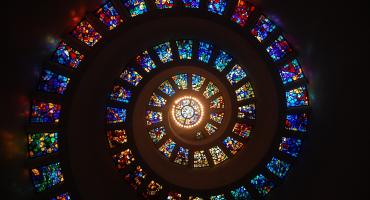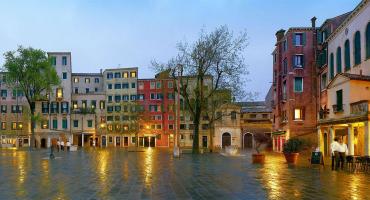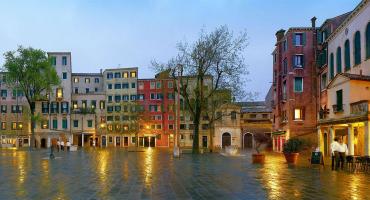A city in the city, with five synagogues, the museum and very tall houses. This itinerary discovering the ancient Jewish district of Venice and its particularities, will take place in a secluded area full of charm, far from the most crowded touristic routes, in an area of the lagoon city to be rediscovered.
Among its many first places, Venice boasts the most ancient and best preserved Jewish quarters in the Old Continent, buit in 1516 following the Serenissima government's arrangements, that confined the Jews in a delimited area of the city.
The genuinely Venetian origin of the word 'ghetto' bears its witnesses, deriving from ‘getto (casting)’ and referring to the foundries that stood in the medieval settlement area of the first German Jewish to whom the cultural transformation of the word is owed.
This area is in the sestiere (district) of Cannaregio, not far from the train station, on the margin of the most crowded tourist itineraries.
The atmosphere of other times and unmistakable physiognomy of the area with lanes and small squares surrounded by very tall houses is one of the reasons why this visit can not be missed. Walking through its lanes and its small squares you will notice that this area still preserves a small centre of Jewish life.
The starting point of this itinerary and landmark of the guided tour of the monuments of Ghetto is the Jewish Museum, equipped with a website full of historic and practical information and a map of the Ghetto.
This itinerary will take you to the discovery of the Ghetto's five synagogues which are simple outside as much as are sumptuous inside, and of inimitable specialities of the Jewish lagoon cuisine.
At the end, if you have another day on disposal, we advise you to conclude this itinerary with a visit to the evocative Jewish cemetery in Lido.
1° stage: From the train station take Strada Nuova (direction: Rialto), after Ponte delle Guglie turn left and then right into Sotoportego del Ghetto Vecchio, which once upon a time was a gate marking the boundary of the Jewish Ghetto, from which the Jewish weren’t allowed to come out. Continue until Campo del Ghetto Novo where, near the Scuola Grande Tedesca, there is the Museum of Jewish Ghetto. It’s an astonishing museum that manages to compress in such a moderate space centuries of history of the Jewish community of Venice.
The collection takes in consideration first of all the objects to do with worship and Jewish religion festivities, from Shabbat, the day dedicated to praying, to Pesaq, the Jewish Easter. In the centre of attention there is the Torah scroll (Sefer Torah) with all its bibliography: in fact, the scared scroll is covered by a mantle (Meil) and surmounted by a crown (Ataràh); it is cherished in the Aron Ha Kodesh (literally, Cupboard of Sanctity) whose doors are decorated with satin and silk fabrics (Parokhet); it gets read with help of wrought silver penholders with a small hand at the end (Yad).
There aren’t missing curious antiques, such as nuptial agreements (Ketubboth), in the form of a handwritten and tempera coloured scroll, with rules for protection of the woman in case of a marriage break-up, as acknowledged by Jewish tradition.
In the practice, the museum is a reference point for guided tours of the synagogues and the Jewish cemetery on Lido.
2° stage: after the visit to the museum, you could visit three splendid synagogues that are found in Campo del Ghetto Novo, next to the Museum, and then continue towards the other two, in Campiello delle Scuole, in Old Ghetto.
In 1719 in the ghetto of Venice there were as many as nine synagogues on disposal to three ‘nations’ present at the same time – German, Levantine and Sephardic – settled in the city centuries ago as the Jews were expelled from their original lands. It’s an extraordinary fact that in the city glossary instead of a word ‘synagogue’ a word ‘scuola (school)’ was preferred, coined originally for the worship buildings of Christian confraternities.
Another particular feature of the Venetian synagogues is the rectangular layout, with the scared arch and the podium facing each other from the shorter sides while the benches are aligned to the longer ones. On the walls, biblical quotations in Jewish; characteristic furnishings with brass and silver chandeliers and a great abundance of precious fabrics and red curtains.
In Campo del Ghetto Nuovo there are three synagogues remained, founded in 16th century and hidden behind facades of pre-existing buildings: Scuola Grande Tedesca, Scuola del Canton and Scuola Italiana.
In the small square of these synagogues, in the centre of the Old Ghetto, there are other two, Scuola Levantina and Scuola Spagnola, having similar foundations but which were updated with a certain architectural splendour in 17th century.
Before leaving the ghetto we suggest a break in order to discover the cuisine of the Venetian Jews, in the restaurant «Gam Gam» in Sottoportego del Ghetto Vecchio (Tel. 041.715284) or in the restaurant «I quattro rusteghi» in Campo del Ghetto Nuovo (Tel. 041.715160).
Cuisine of the Venetian Jews
The Jewish cuisine revolves around the concept of kosher food, or rather ‘conformed’ according to the dictates of Torah applied in the daily of the rabbi.
Motives of various types, without being able to go into details, involve forbidden use of pork, as already known, but also of rabbit meat and eel, shellfish and molluscs in general, meat in general cooked in milk and its by-products, cream and butter. This is valid in full, but Venice is a special case because in no other place in the world such overlapping of customs is verified.
In the ghetto, a simple cuisine of the Ashkenazi Jews who came from Germany, meets the exuberant one of the Sephardics, natives from the southern France and Spain, without counting the contribution of the Levantines and many other heterogeneous presences in connection with maritime trades.
The symbol dish of the Jewish cuisine are sardines ‘in sauce’, a sweet & sour where vinegar and onions get mixed with sultanas and pine-seeds – but many others are specialities of this very particular ethnic trend.
3° stage: If you really like skittish and charming places, loaded with history, the ancient Jewish cemetery on Lido is the place for you.
Take a waterbus for Lido and, once you get off, by bus or on foot, go along the lagoon coast until San Nicolò, a part of the most northern end of the island.
A row of cypresses will guide you towards the enclosure of the ancient Jewish cemetery, inaugurated in 1386 on accordance of Serenissima and had remained in use until 1938, year of promulgation of racial laws as part of the fascist dictatorship. In addition to five centuries of history the area had gone through diverse mishaps, from expropriations for military reasons to vandalisms as a result of foreign occupations, but it still hasn’t lost its physiognomy. In 1999 a praiseworthy reclamation work brought to cataloguing of 1,200 tomb stones, dating back from 1550 to the beginning of 18th century, that today come into sight between ivy and ferns.
Many stories, told by the museum guide, that bring back to life the memory of the cosmopolitan Jewish community of Venice.
Useful information:
Jewish Museum,
Address: Cannaregio 2902/b, Campo del Ghetto Nuovo
Telephone tel. + 39 041 5246083
e-mail ghettovenezia@operalaboratori.com
Website https://www.ghettovenezia.com/museo/
Services: educational activities, bookshop, museum publications, shop, guided tour



